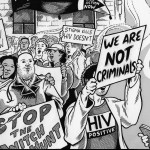Although I remember it like it was yesterday, the day I received my HIV diagnosis was in June 1984—39 years ago. I had just started graduate school at the University of South Florida’s Tampa campus. When I went for my results, I was ushered into a room with more than 25 medical professionals. I turned to the nurse and said, “I guess I have it; otherwise, these people wouldn’t be here.”
This strange disease—HIV, or human immunodeficiency virus—hadn’t yet been named. The lead doctor of the research study informed me that I carried an antibody and had been exposed to the virus. I was only 23 years old and believed I had a long life ahead of me. I was gobsmacked when the doctor told me he wasn’t sure how long I had to live but that it was probably less than three years. I truly didn’t know what to do with my remaining years. I walked across campus, went to the registrar’s office and immediately dropped out of school. Then, I drove across the Howard Frankland Bridge into St. Petersburg and quit my job as a buyer for a major department store.
Now what? My life spiraled downward. I was out of control and so was my drinking. Slowly, I started to realize that my life wasn’t ending as quickly as I’d imagined. Apparently, I still had some years left on this planet. I did some serious soul searching, looking for my calling—the fire in my belly. During this time of reflection, I discovered that education was my calling. I took a few classroom management courses, interviewed with some schools and voilà! I became an English and history teacher.
This was before the advent of effective HIV medications. I started to lose weight. Fortunately, I listened to my doctor and stopped drinking and persevered. Quitting drinking significantly helped my journey. As various HIV drugs became available, it seemed I took all of them. I figured if I was going to die, what the heck? I took AZT, but it was short-lived. I saw what it was doing to my late spouse and many others. I told my doctor that I would wait for something else. I had the worst time with liquid Norvir. At one point, there was a sterility issue with the Norvir capsules, so I made my own using gelatin capsules, liquid Norvir and an eyedropper. When pharmacies around me had a shipping issue with the gelatin capsules, again, I got creative. I resorted to making chocolate milkshakes with liquid Norvir mixed into them. I cannot lie. The liquid Norvir tasted like gasoline. Yet, I persevered. I knew it was working because I began gaining weight.
Dealing with these issues helped me find my voice as an advocate and activist. I got involved with ACT UP and worked as a case manager when there were none. I was able to be a buddy to a few others who were living with HIV. As a buddy, I took people to various appointments, did their shopping, sat with them and basically let them know they mattered.
I also protested on many occasions. I was in the middle of a die-in at the rotunda at the Capitol. I was part of an ACT UP protest at the Food and Drug Administration. I participated in various events, knowing that I could be fired. It was illegal to be a teacher in the Pinellas County Schools system if you were gay or HIV positive. I like to think that these actions guided me along my path of activism.
I also spent four years in Syria teaching at a private English-medium school [a type of school where subjects other than English language are taught in English]. I lived in Homs and Damascus. I never applied for residency, for this would have required me to submit to a blood test. I knew that when the blood test showed that I was HIV positive, I would have been escorted out of the country. Instead, I had my visa renewed every six months. The dangerous part was getting my medicine. I had to go to Lebanon. I would pick up my meds, hide them in the recesses of my car and drive back to Syria, hoping that the border guards wouldn’t discover them.
Fast-forward to 2009. I returned to the United States to get my visa renewed, and during this time, I was diagnosed with a brain tumor and toxoplasmosis. I had two T-cells. I named them Adam and Eve. Thanks to the partnership between my infectious disease doctor, my oncologist and my neurosurgeon, I was finally cleared of the tumor, my T-cells rose, and I no longer looked like death warmed over.
In 2014, I moved from the beaches of St. Petersburg to the mountains of Tennessee. I had fallen in love with a man named Butch Ferney, and the whole long-distance relationship thing wasn’t going to cut it. He was very active in HIV issues and events in Tennessee. Unfortunately, in 2015, he passed away because his pancreas burst. He left behind a legacy of HIV activism in Tennessee, a son and three granddaughters. I continue my HIV advocacy and activism for him, his son and his three granddaughters—and for myself.
Things are very tough in Tennessee as far as HIV prevention is concerned. I still actively advocate for PLWHIV [people living with HIV] in the state. As Elaine Stritch sang in Follies, “I’m still here!” I will continue the journey of HIV advocacy and activism until I can no longer.
What three adjectives best describe you?
Authentic, caring, resilient.
What is your greatest achievement?
Living to the ripe age of 62—almost 63!
What is your greatest regret?
Saying goodbye to my late partner.
What keeps you up at night?
The current state of affairs in Tennessee.
If you could change one thing about living with HIV, what would it be?
Less stigma and more understanding.
What is the best advice you ever received?
Be true to yourself, no matter what.
What person in the HIV community do you most admire?
Shanell McGoy, PhD (the director of HIV/STD for the Tennessee Department of Health).
What drives you to do what you do?
Being the voice for the voiceless.
What is your motto?
Watch out! I have just begun to blossom.
If you had to evacuate your house immediately, what is the one thing you would grab on the way out?
The letter that my dad wrote to my mom while he was in the hospital.
If you could be any animal, what would you be? And why?
A poodle. It looks all fluffy and such, but it was bred to hunt and kill.
Editor’s Note: Mark Grantham was listed on the 2015 POZ 100 and the 2016 POZ 100.
https://www.poz.com/article/poz-100-e-g-28024-8004
https://www.poz.com/article/2016-poz-100-fg
Click the image below to share your POZ Story.








2 Comments
2 Comments